Witness the profound tale of prophecy and peril in Matthew's account of Christmas, revealing depths beyond the traditional narrative of joy.
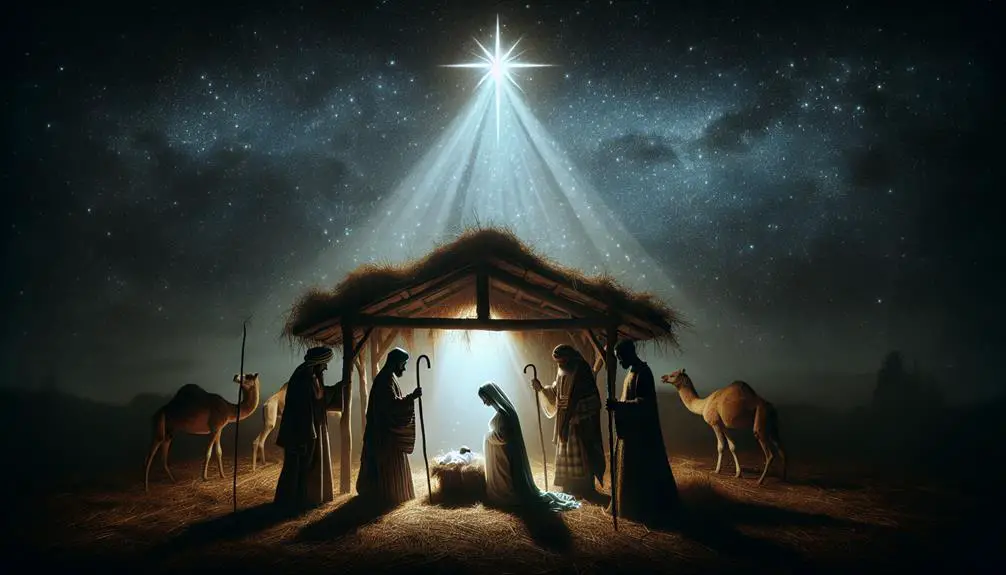
Christmas Story in the Bible Matthew
Interestingly, over 2 billion people globally celebrate Christmas each year, yet not everyone knows the detailed narrative from the Gospel of Matthew that started it all. You're probably familiar with the basics: the journey of the Magi, the guiding star, and the gifts they brought.
But have you ever considered how Herod's reaction plays a crucial role in understanding the story's depth? This account isn't just a tale of joy and giving; it's a complex narrative filled with prophecy, danger, and divine intervention.
Let's explore how this ancient text holds relevance to our modern celebrations and why it's more than just a story of birth.
Key Takeaways
- Matthew's account emphasizes the fulfillment of Jewish prophecies through Jesus' birth.
- The visit of the Magi, guided by the Star of Bethlehem, highlights divine intervention.
- King Herod's fearful response and massacre order underscore his tyranny and fear of Jesus' prophesied power.
- The narrative combines celestial phenomena and ancient texts to deepen the understanding of Jesus' early life and divine mission.
The Prophecy Fulfilled
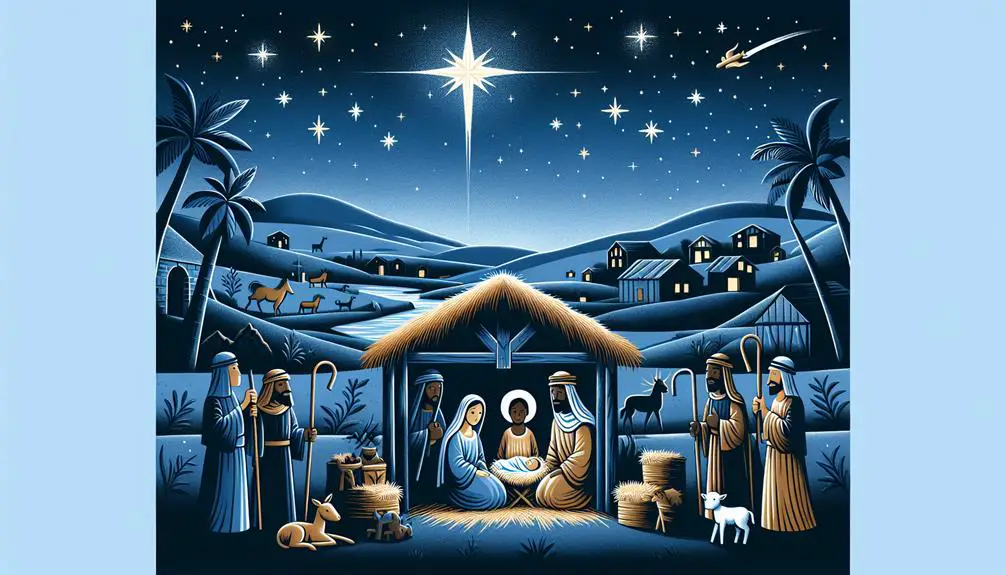
As the narrative unfolds in Matthew, it becomes evident that Jesus' birth remarkably fulfills the ancient prophecies, revealing a meticulous alignment with scriptural expectations. The concept of the Virgin birth, central to the Christmas story, stands as a profound testament to this fulfillment. Matthew meticulously cites the prophecy from Isaiah 7:14, 'Behold, a virgin shall conceive and bear a son, and they'll call his name Immanuel,' which means God with us. This specific reference not only underscores the miraculous nature of Jesus' birth but also highlights the divine orchestration behind the scenes, aligning with the prophecy to the letter.
Furthermore, the shepherd's visit, while more prominently featured in Luke's account, complements Matthew's narrative by underscoring the humility and universality of Jesus' arrival. The shepherds, being lowly and ordinary citizens, receiving the angelic announcement, emphasize God's message that the Messiah comes for all strata of society, not merely the elite or the expectant. This visitation aligns with the prophecies foretelling a Messiah who'd shepherd His people, embodying humility, accessibility, and a profound connection to the marginalized.
Analyzing these elements, it's clear that Matthew's account is steeped in a profound respect for and adherence to Jewish prophecy, carefully presenting Jesus' birth as the culmination of centuries of anticipation. This adherence to prophecy not only validates the miraculous nature of the Virgin birth but also reinforces the message of hope and inclusivity heralded by the shepherd's visit. Through these intricate fulfillments, Matthew's narrative weaves a compelling tapestry of divine intervention and historical continuity.
The Journey of the Magi
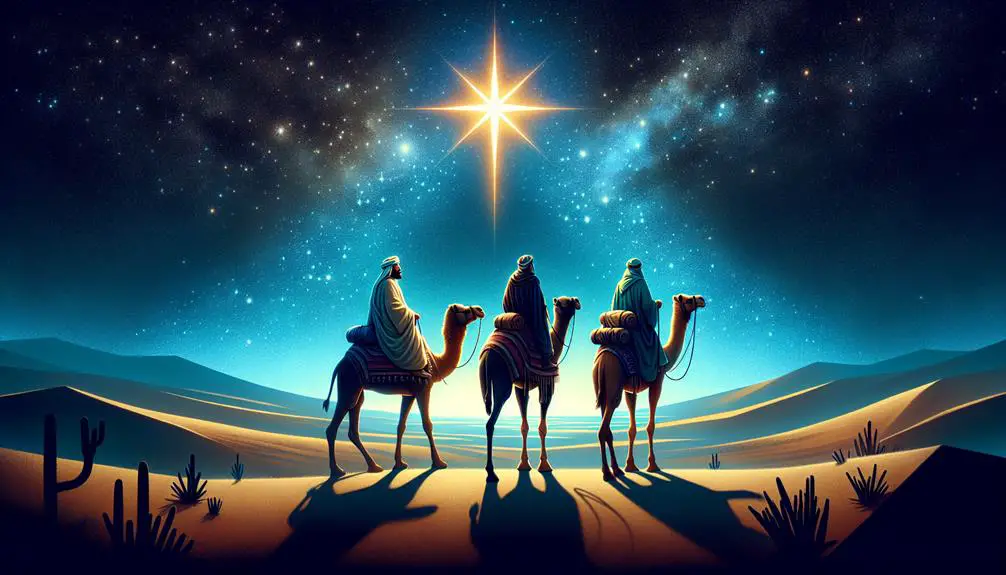
You'll find the Magi's journey to Bethlehem, guided by the Star of Bethlehem, as a pivotal moment in the nativity narrative.
Their origins and the prophecy they sought to fulfill underscore their significance in understanding early Christian symbolism.
The gifts they brought for the newborn, rich in symbolic meaning, further illuminate the depth of this biblical episode.
Magi's Origins and Prophecy
The Magi, often referred to as Wise Men, embarked on an extraordinary journey from the East, guided by prophecy and celestial phenomena, to pay homage to the newborn King of the Jews. Their origins and motivations are deeply rooted in ancient traditions, particularly:
- Zoroastrian connection: They were likely influenced by Zoroastrian beliefs, emphasizing the arrival of a savior.
- Astrological practices: Their journey was significantly shaped by meticulous observations of the stars.
- Prophecy fulfillment: They sought to witness the fulfillment of ancient Jewish prophecies.
- Cultural exchange: Their journey symbolizes the blending of Eastern and Western spiritual practices.
- Divine guidance: Despite their reliance on astrology, their story highlights a divine orchestration beyond mere celestial navigation.
Analyzing their journey offers a profound understanding of the interconnectedness of faith, prophecy, and the search for divine truth.
Star of Bethlehem Guide
Having explored the origins and motivations of the Magi, we now turn our focus to the celestial phenomenon that guided their journey: the Star of Bethlehem. This star, central to the Christmas narrative, has spurred various astronomical theories and modern interpretations attempting to identify its nature.
Scholars have proposed that it could have been a planetary conjunction, a comet, or a supernova, each hypothesis aiming to align historical astronomical events with the biblical timeline. Modern interpretations lean towards rare celestial alignments, suggesting that the Magi's star might've been an extraordinary astrological event.
These investigations not only enhance our understanding of the historical context but also bridge the gap between ancient texts and contemporary astronomical knowledge, offering a compelling analysis of how the heavens might've proclaimed the birth of Jesus.
Gifts for the Newborn
Upon reaching their destination, the Magi presented three symbolic gifts to the newborn, embodying profound theological and prophetic significance within the Christian narrative. These gifts weren't arbitrary but were laden with meaning, deeply intertwined with cultural traditions and modern interpretations.
- Gold: Signifying Jesus' kingship, gold reflects his divine authority and status.
- Frankincense: Symbolizing Jesus' priestly role, it represents prayer and the divine nature of his ministry.
- Myrrh: Foretelling his mortality and suffering, myrrh underscores the human aspect of Jesus and his eventual death.
Cultural traditions: These gifts have influenced the way Christmas is celebrated, incorporating gift-giving practices.
Modern interpretations: They offer rich material for theological reflection, highlighting themes of sacrifice, worship, and kingship in contemporary Christian thought.
The Star of Bethlehem
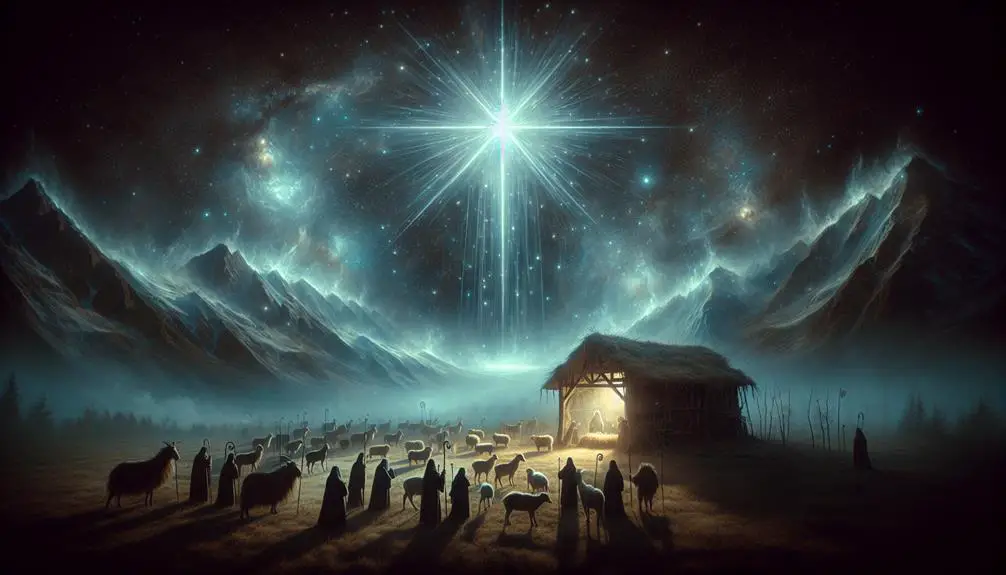
Astrologers and scholars alike have long debated the nature and significance of the Star of Bethlehem, a celestial event that guided the Magi to the birthplace of Jesus as described in the Gospel of Matthew. This phenomenon has spurred a multitude of astronomical theories and cultural interpretations, each proposing a different understanding of what the star was and what it symbolizes.
Astronomical theories often delve into historical astronomical events to try to identify the Star of Bethlehem. Some propose it was a supernova, a rare and brilliant exploding star, visible to the naked eye, that could have caught the attention of the Magi. Others suggest it might've been a conjunction of planets, where two or more planets align in the sky, creating a striking visual effect. This theory often points to specific alignments involving Jupiter and Saturn, which were known to ancient astrologers and could have been interpreted as a significant celestial sign.
Cultural interpretations, on the other hand, explore the symbolic meaning of the star within the context of the time. They suggest that the star's appearance served not only as a navigational guide for the Magi but also as a divine announcement of the birth of a king. This interpretation aligns with the Jewish expectation of a Messiah and the Magi's understanding of celestial events as omens or messages from the divine.
Both astronomical theories and cultural interpretations contribute to a richer understanding of the Star of Bethlehem, illustrating its significance not just as a historical event but as a symbol woven into the fabric of the Christmas narrative.
Herod's Deadly Decree
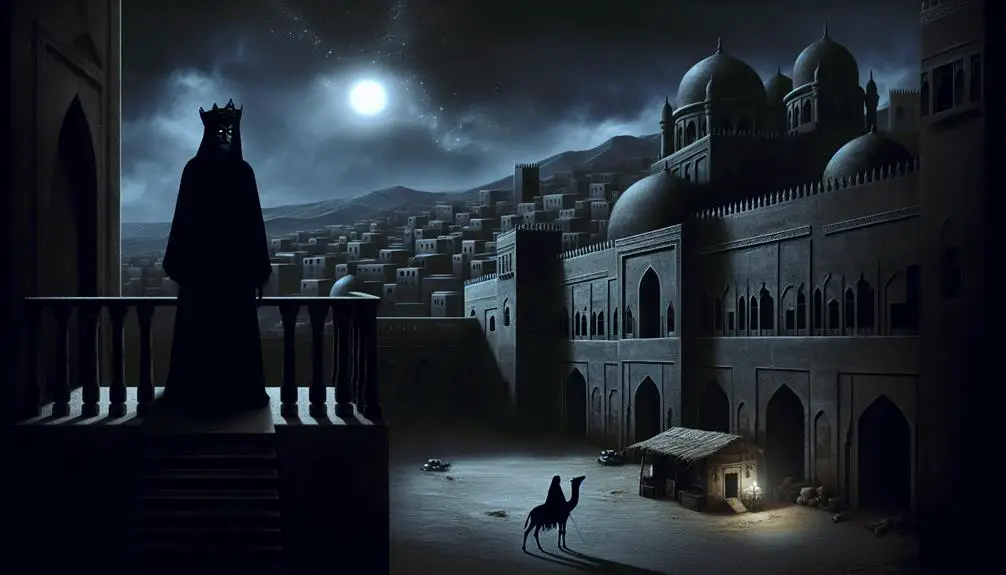
You must now turn your attention to King Herod's response to the birth of Jesus, marked by a mixture of fear and tyranny. His decree to massacre the innocents in Bethlehem is a harrowing reflection of his attempt to eliminate any threat to his throne.
This event not only showcases the brutal lengths to which Herod would go to secure his power but also sets a somber backdrop against the nativity narrative, highlighting the profound darkness from which the light of the world emerged.
Herod's Fearful Response
Feeling threatened by the news of a newborn king, Herod initiated a brutal decree to eliminate any potential rivals to his throne. This move was deeply rooted in Herod's paranoia and the prevalent political instability of the time.
- *Herod's paranoia* wasn't just a personal flaw; it was a political strategy to maintain power amidst uncertainty.
- Political instability made any claim to kingship a direct threat to Herod's reign, necessitating drastic measures.
- Herod's response underscores the vulnerability of power; even the mightiest rulers fear replacement.
- This decree highlights the tragic intersection of fear and power, where the perceived need for control leads to catastrophic decisions.
- Understanding Herod's response requires recognizing the complex interplay between personal insecurity and the maintenance of political dominion.
Massacre of Innocents
In a grim assertion of power, Herod's decree to massacre the innocents laid bare the devastating lengths to which he would go to eliminate any threat to his throne. This act, couched within the narrative of Matthew's Christmas story, invites you to ponder the ethical considerations and historical accuracy of such an event.
Aspect |
Analysis |
|---|---|
Ethical Issues |
The massacre raises profound questions about the moral implications of power and fear-driven decisions. |
Historical Proof |
Evidence outside the biblical narrative is scarce, leading scholars to debate the event's veracity. |
Impact on Faith |
It challenges believers to reconcile the horror with a benevolent deity's plan. |
Literary Role |
Serves as a stark contrast to the hope the birth of Jesus represents, emphasizing the darkness from which light emerges. |
You're urged to critically assess not just the historical but the ethical dimensions of such narratives.
The Gifts of the Wise Men
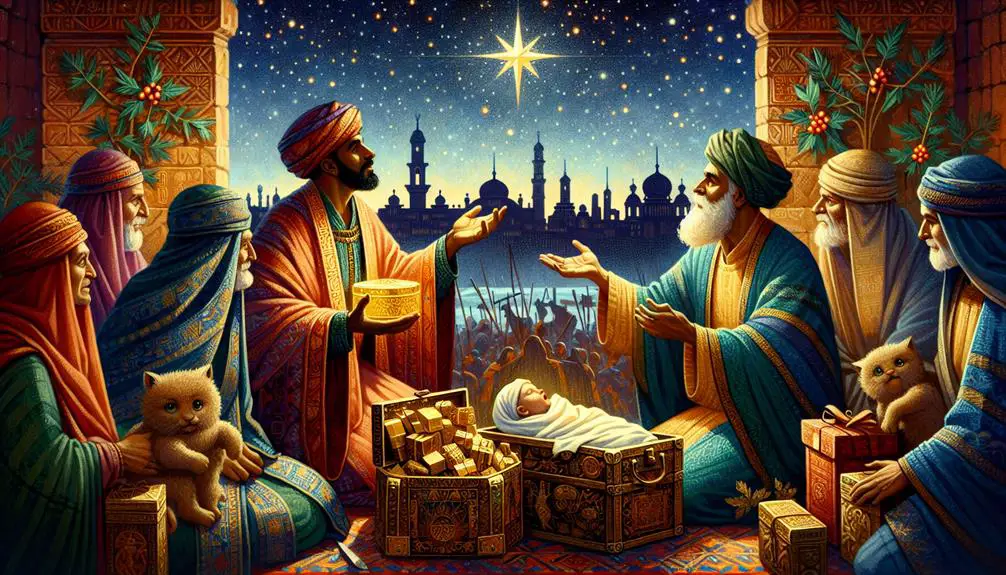
Upon their arrival, the wise men presented Jesus with gifts of gold, frankincense, and myrrh, each bearing significant symbolic meaning within a Christian theological context. These gifts, while rich in their material value, carry layers of meaning that transcend their economic implications, weaving a tapestry of cultural interpretations and theological insights.
- Gold, often associated with royalty and divinity, underscores Jesus' kingship and divine nature. This precious metal, universally recognized for its value, signifies the acknowledgment of Jesus as the King of Kings, a foundational belief in Christian theology.
- Frankincense, a resin used in ancient times for its aromatic properties in religious rites, symbolizes Jesus' priestly role. Its use in worship and prayer points to the divine connecting the earthly with the heavenly, highlighting Jesus' mediation between God and humanity.
- Myrrh, known for its embalming properties, foreshadows Jesus' mortality and his eventual suffering and death. This gift, though seemingly morbid, underlines the human aspect of Jesus, embracing the prophecy of his sacrificial death for humanity's salvation.
- The economic implications of these gifts reflect the wise men's recognition of Jesus' significance, investing resources to honor him. This act of giving not only denotes respect but also foreshadows the sacrificial nature of Jesus' mission.
- Cultural interpretations of these gifts vary, with some seeing them as symbolic of Christ's roles as prophet, priest, and king, while others view them as a testament to Jesus' bridging the divine and the human.
In presenting these gifts, the wise men provide a rich narrative layer to the Christmas story, embedding deep theological and cultural significances that continue to resonate within Christian discourse.
The Flight to Egypt

After presenting their gifts to Jesus, the wise men's departure triggers a pivotal moment in the Christmas story, as Joseph receives a divine warning that leads the Holy Family to seek refuge in Egypt. This episode, rich in theological and historical implications, underscores the protective guidance provided through angelic intervention. The narrative, as recounted in the Gospel of Matthew, hinges on the angel warning received by Joseph in a dream. This dream guidance isn't merely a plot device but a profound expression of divine providence and the fulfillment of Old Testament prophecies, illustrating the interconnectedness of the biblical narrative.
The angel's warning to Joseph is direct and urgent, compelling him to take Mary and Jesus to Egypt to escape King Herod's impending massacre. This directive encapsulates the theme of divine preservation against formidable threats. The flight to Egypt symbolizes a formative journey, not only in the physical sense but also in the spiritual maturation of the Holy Family and their unwavering obedience to God's will.
Analyzing this episode, scholars often emphasize the typological significance of Egypt as a place of refuge and a symbolic antechamber for the eventual deliverance of the Israelites, drawing parallels with the Exodus. The angel's intervention through dream guidance serves as a testament to the continuous divine oversight and guidance that characterizes the entire biblical narrative.
In essence, the Flight to Egypt is a narrative of faith, obedience, and divine intervention, showcasing the lengths to which divine providence will go to protect the innocent and fulfill the larger salvific plan outlined in the scriptures.
The Return to Nazareth
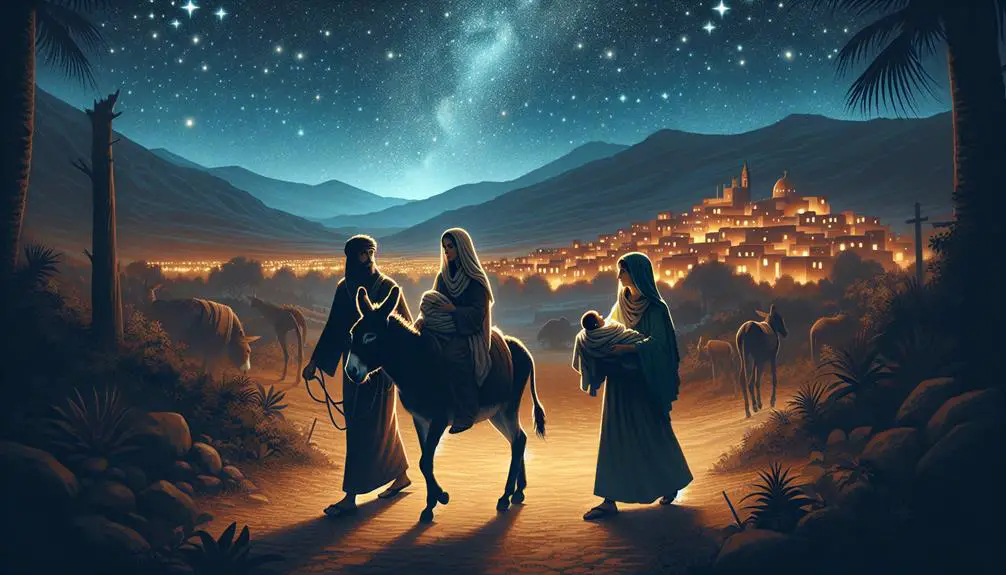
Following the harrowing experience in Egypt, the Holy Family's return to Nazareth marks a significant phase in their journey, embodying a deeper fulfillment of biblical prophecies and divine guidance. This return wasn't merely a geographical transition but a strategic move underpinning the unfolding of Jesus' Nazarene identity. Nazareth, a town of no great repute in ancient Judea, becomes the backdrop for the nurturing of the Messiah, in alignment with the prophecies that He'd be called a Nazarene.
- Cultural Context: Nazareth's obscurity plays a crucial role in the divine plan, allowing Jesus to grow up away from the limelight, in simplicity and humility.
- Fulfillment of Prophecy: The return and subsequent residence in Nazareth fulfill specific Old Testament prophecies, anchoring Jesus' mission in the scriptures.
- Carpentry Tradition: Joseph's profession as a carpenter, a tradition Jesus would later adopt, underscores the importance of labor and craftsmanship in His earthly life, offering a model of sanctity in ordinary work.
- Formation of Jesus' Identity: Nazareth shapes Jesus' early years, embedding in Him the values and virtues of a close-knit community, preparing Him for His public ministry.
- Divine Guidance: The decision to return to Nazareth, guided by an angelic warning to Joseph, illustrates the continuous divine intervention and protection over Jesus' life.
Analyzing the Holy Family's return to Nazareth reveals layers of theological and historical significance, deeply intertwined with Jesus' Nazarene identity and the carpentry tradition. This phase of Jesus' life invites reflection on the divine wisdom orchestrating His earthly journey, preparing Him for His ultimate mission.
Theological Significance
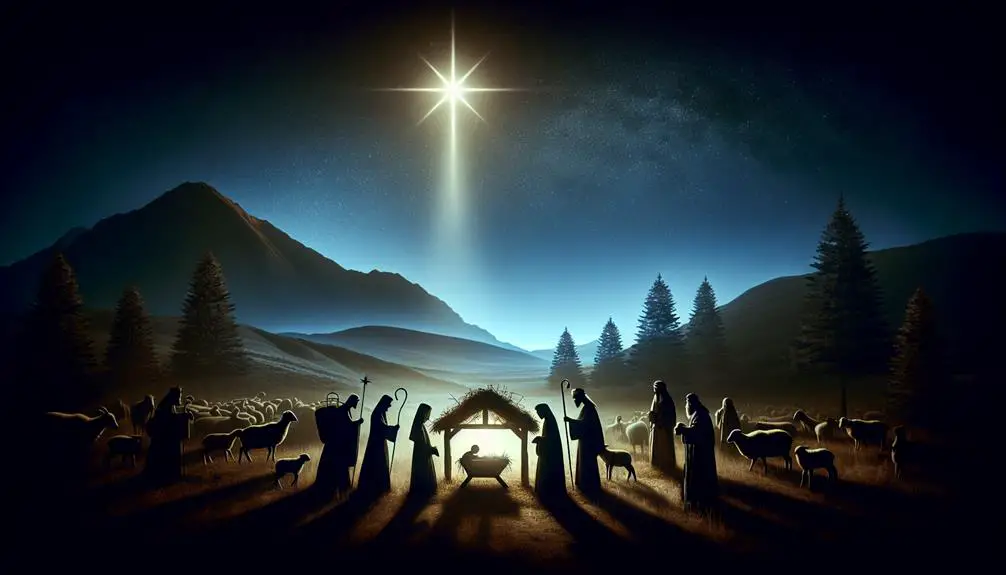
Exploring the theological significance of the Holy Family's return to Nazareth reveals deeper insights into the divine orchestration of Jesus' life and mission. This event isn't merely a historical footnote; it's a pivotal moment that intertwines with the concept of divine incarnation and the fulfillment of Messianic expectations deeply rooted in Jewish tradition. The return to Nazareth encapsulates the humility and obscurity that would mark Jesus' early life, setting the stage for a ministry that would upend conventional understandings of power and divinity.
You'll find that the divine incarnation, central to Christian theology, is underscored by Jesus' upbringing in Nazareth. This small, seemingly insignificant town becomes the backdrop for the early years of the Son of God, highlighting the paradox of the divine choosing the lowly and ordinary for His dwelling among humanity. This aspect challenges you to reconsider the nature of divine intervention and presence in the world, emphasizing accessibility and humility over grandeur.
Moreover, the fulfillment of Messianic expectations through Jesus' life and mission is intricately connected to His Nazarene roots. The prophets spoke of a Messiah who'd emerge from humble beginnings to establish God's reign of peace and justice. Jesus' return and upbringing in Nazareth fulfill these prophecies in an unexpected way, compelling you to reflect on the ways God's promises unfold beyond human assumptions and limitations.
Frequently Asked Questions
How Do Different Christian Denominations Interpret the Differences Between Matthew's and Luke's Accounts of the Christmas Story?
When you delve into how Christian denominations tackle the variances between the two Gospel accounts of Jesus' birth, you'll notice a fascinating blend of denominational unity and interpretive methodologies at play.
Each tradition employs unique analytical lenses, yet there's a shared respect for the theological significance of both narratives. This scholarly approach underscores a commitment to understanding the nuanced differences while appreciating the profound, unifying message of Christ's advent.
Are There Any Significant Archaeological Findings That Support or Challenge Details of the Christmas Story as Narrated in Matthew?
You're looking into the historical backdrop of certain events, focusing on archaeological evidence. While there's no direct proof confirming or refuting specifics, findings related to Herod's reign and various analyses of star phenomena offer insights.
These aspects indirectly support the timeframe and celestial events mentioned. However, the evidence doesn't directly address the narrative's details but provides a scholarly foundation for understanding the historical context in which these stories were set.
How Has the Portrayal of the Christmas Story in Matthew Influenced Modern Christmas Traditions and Symbols?
You'll find that modern Christmas traditions and symbols are deeply influenced by historical narratives. Gift exchanges echo the Magi's offerings, symbolizing generosity and goodwill.
Seasonal music, often recounting the nativity, fosters a shared sense of community and celebration. These practices, rooted in ancient stories, shape how we experience the holiday season today, blending historical reverence with contemporary festivity to create a rich, multicultural tapestry of celebration that transcends the original narrative.
What Are the Historical and Cultural Contexts of the Time That Might Explain Why Matthew Included Specific Details in His Christmas Story?
In your quest for understanding, consider how historical and cultural contexts illuminate why certain details shine in ancient narratives. The genealogy significance roots the story in deep ancestral importance, anchoring it in a rich heritage.
Meanwhile, the Star interpretation guides not just wise men, but also symbolizes divine intervention in human affairs. Such elements, analyzed through a scholarly lens, reveal how cultural and historical backgrounds sculpt narratives with profound depth and resonance.
How Do Scholars Reconcile the Timeline and Events of Jesus' Birth in Matthew With External Historical Records From the Same Period?
You're diving into how scholars align the story of Jesus' birth with historical records. They scrutinize the star interpretation and Herod's timeline closely. By examining astronomical events and analyzing Herod's reign, they piece together a timeline that fits both the biblical narrative and external history.
This involves a detailed review of historical documents and archaeological findings, offering a comprehensive view that bridges the gap between religious texts and historical chronology.
Conclusion
In analyzing the narrative arc of Matthew's account, you witness a profound fulfillment of ancient prophecies underscored by celestial phenomena. The Magi's journey, guided by the Star of Bethlehem, juxtaposes the divine's silent orchestration against Herod's brutal regime, introducing a stark contrast in leadership styles.
The gifts—gold, frankincense, and myrrh—echo a kingly anointing, yet paradoxically hint at mortality. This flight to Egypt and subsequent return encapsulate a motif of exile and restoration, weaving a complex theological tapestry that underscores the Messiah's paradoxical kingdom—a realm where divine and earthly sovereignties intersect, challenging contemporary notions of power and governance.

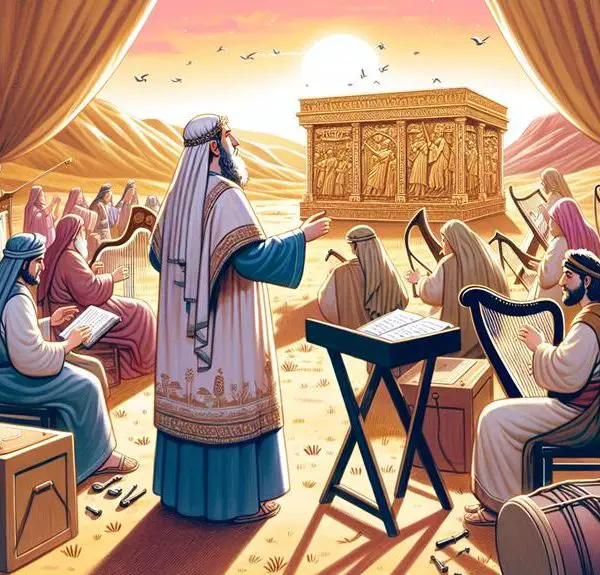
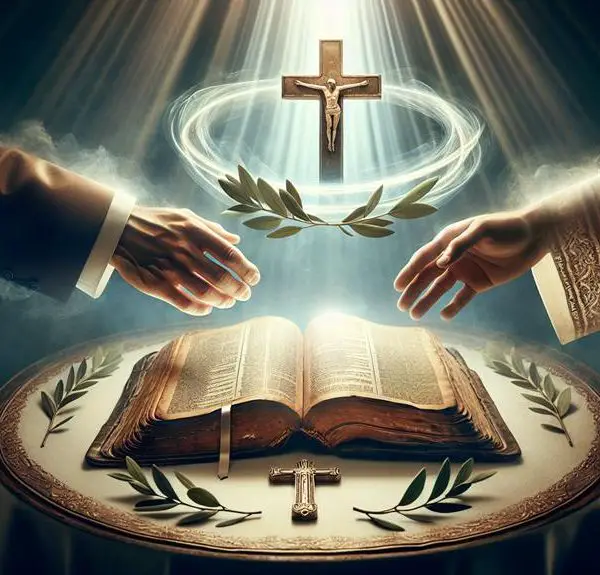
Sign up